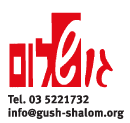|
|
|
|
The Ramallah Initiative The slogan was: "A New Hope". A new spirit is necessary in order to overcome despair and pessimism, in view of the violent events between the Israeli army and the Palestinians, as well as between the Palestinians themselves. In order to rekindle hope, close Israeli-Palestinian cooperation is needed, as well as steadfastness and courage. Timing and location of the conference underlined more than anything else: a day before, the Israeli army had invaded the center of Ramallah, killed four bystanders and caused an explosion of anger among the Palestinian population. Less than 24 hours later, dozens of Israeli peace activists came to the same place in order to hold out their hands to their Palestinian colleagues and to create a new joint framework for the struggle against the occupation and for peace. However, in spite of the hesitation, it was decided to hold the meeting precisely at this place and time, even if some of the invited persons would fail to come. At the impressive opening session, representatives of 23 Palestinian, 22 Israeli and 15 international organizations were present, due to the serious preparations of the organizing Faculty for Israel-Palestine Peace. After hearing very depressing reports about the situation in the occupied Palestinian territories and the ongoing annexation and settlement activities, the discussion on the character and direction of the joint action began. The deliberations, which also split into workshops, continued for three days. Most of the participants remained in Ramallah during all the time. Gush Shalom was represented by Uri Avnery, Rachel Avnery and Teddy Katz. The consensus was that each member organization should continue to carry out their specialized activities, and that the planned joint coalition should concentrate on actions that needed a unified effort of all the forces, and especially full Israeli-Palestinian cooperation, with the participation of the international organizations. In the course of the discussion, a lively debate over the course of central effort developed. While Jeff Halper of the Committee Against Home Demolitions and several others argued that the central effort should be aimed at organizing international protest, members of Gush Shalom and other groups insisted that the main fight should be for public opinion in Israel. They proposed to concentrate on action in the occupied territories and Israel in order to convince the Israeli public that the occupation, which destroys the life of the Palestinians, is causing huge harm to Israel, and that the achievement of peace is the foremost interest of both peoples. The discussion was very practical and focused on specific actions which can be carried out by the proposed coalition - against roadblocks, against the wall, for the release of prisoners, for marking the Green Line, and more. At the end of the three days it was agreed to set up an "Israeli-Palestinian-International Coalition for Ending the Occupation", and to issue the following statement: On Thursday, January 4, 2007, the occupation forces invaded the center of Ramallah in order to kill or capture a "wanted" person. Instead, four bystanders were killed. The next day, January 5, the representatives of 60 Israeli, Palestinian and international peace organizations (23 Palestinian, 22 Israeli and 15 international) came together in Ramallah for three days of deliberations, in order to protest against the bloodshed, demand the end of the occupation and work together for peace between the two peoples. |

